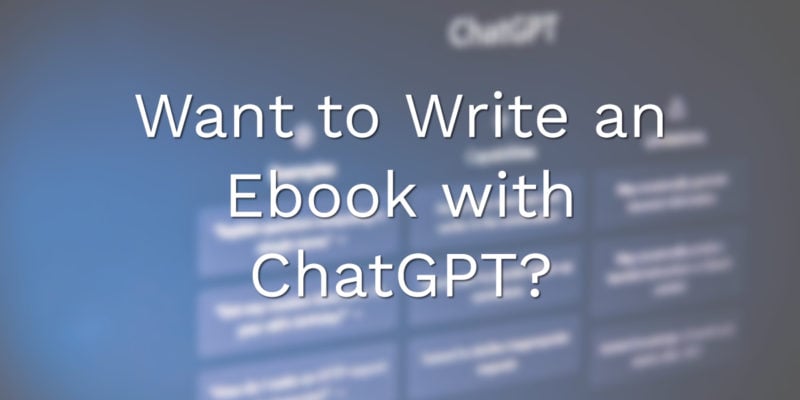Thinking about writing an ebook?
That blank page can look pretty scary, right? But don’t worry – you’ve got a secret helper now: ChatGPT.
I’ve been where you are, staring at that blinking cursor, not sure where to start.
Then I found out how AI could help, and it changed everything.
Now I’m here to show you how to use ChatGPT to turn your ebook idea into reality.
Why Your Ebook Is Important (And Why You Might Be Nervous)
Let’s talk about that voice in your head asking, “Does anyone want to read what I have to say?” I get it. There’s so much stuff out there already, it’s easy to think your voice might get lost. But here’s the truth: your way of seeing things, your experiences – they matter.
Your ebook is more than just words on a screen. It’s a chance to:
- Talk to people who need exactly what you know
- Show you know your stuff
- Make a lasting impact beyond quick social media posts
- Earn money while you sleep (sounds nice, right?)
- Find new opportunities you haven’t even thought of yet
But it’s not just about the good stuff. You’re worried about how long it’ll take, what to do when you get stuck, and if you have enough to say. I’ve been there, and I’m telling you that with the right tools and approach, you can do this.
ChatGPT is Your Writing Partner

Meet your new writing buddy: ChatGPT. It’s like having a friend who’s always ready to bounce ideas around, no matter what time it is. It won’t write your book for you – it’s here to help your creativity flow and make writing easier.
Here’s a quick look at how ChatGPT can help at each step:
| What You’re Doing | How ChatGPT Can Help |
|---|---|
| Coming up with ideas | Suggest topics, find new angles |
| Making an outline | Build chapter outlines, suggest subtopics |
| Doing research | Give background info, point out areas to look into |
| Writing | Help when you’re stuck, grow your ideas |
| Editing | Suggest ways to make things clearer and flow better |
| Marketing | Think up ways to promote, help write ads |
ChatGPT is a tool to make your writing better, not to do it for you. Your own experiences and ideas are what will make your ebook special. Use ChatGPT to help say things better, but always add your personal touch.
How to Create Your Ebook Step-by-Step with ChatGPT

1. Figure Out Your Goal and Who You’re Writing For
Before you start with ChatGPT, think about why you’re writing this ebook. This is your “why,” and it’ll keep you on track as you write. Ask yourself:
- What problem am I fixing for my readers?
- How do I want my readers to feel or what do I want them to learn?
- What can I say that’s different or helpful?
Once you know your goal, think about who you’re writing for. This matters because it affects how you write and what examples you use.
Try this prompt with ChatGPT:
“Create a detailed reader persona for an ebook about [your topic]. Include demographics, goals, challenges, and current knowledge level.”
Your Ideal Reader
Think of the perfect person to read your book. Give them a name and a story. It’ll make writing feel like you’re talking to a real person. Here’s an example:
| Detail | Description |
|---|---|
| Name | Sarah |
| Age | 35 |
| Job | Marketing Manager |
| Wants | More people engaging on social media |
| Problems | Not much time, small budget |
| Knows | Some stuff about social media marketing |
Now you’re not just writing for anyone – you’re writing for Sarah. You know what she’s struggling with and what she wants to achieve. You’re here to help her get there.
Want to dig deeper? Ask ChatGPT:
“What are the top 5 questions my target audience [describe audience] might have about [your topic]?”
This will help you focus on the most important issues your readers care about.
2. Pick a Great Title and Subtitle
Your title and subtitle are super important. They need to grab attention and show people why they should read your book. ChatGPT can help here. Try asking it:
“Give me 10 catchy titles for a book about [your topic] for [your target reader].”
Look at what ChatGPT suggests and use it to spark ideas for a title that really fits your book. Keep in mind:
- Keep it short and clear
- Use strong words that show action
- Show how it’ll help readers
- Maybe use numbers (like “7 Ways to…”)
- Make it stand out from other books like yours
Take your time with this. Your title often decides if someone will check out your book or not.
Pro Tip: Once you’ve got a few title ideas, ask ChatGPT to generate potential subtitles for each. A good subtitle can clarify your book’s purpose and appeal to your target reader.
3. Make a Detailed Plan
A good plan keeps your ideas organized and helps you write without getting lost.
Here’s how to use ChatGPT to make a solid plan:
- Start simple: Ask ChatGPT to make a basic outline for your book topic.
- Add more details: Look at the outline and ask ChatGPT to add more to specific parts.
- Go deeper: For each main point, ask ChatGPT to suggest things to talk about, examples, or stories you could include.
- Check it makes sense: Once you have a full outline, ask ChatGPT to look at how it flows and suggest any changes.
- Fill in gaps: Use ChatGPT to think of anything you might have missed.
Use this prompt to start your outline:
“Generate a comprehensive chapter outline for an ebook about [your topic], including main points and subpoints for each chapter.”
Always review and change the outline based on what you know and want for your book. It’s your map, so make sure it feels right to you.
Pro Tip: Write down how many words you think each part will be. This helps keep your book balanced and gives you small goals to aim for as you write.
Structuring Your Chapters:
For each chapter, try to include:
- An engaging introduction
- Clear main points (3-5 is often a good number)
- Supporting evidence or examples for each point
- A summary or key takeaways
- A transition to the next chapter
Ask ChatGPT:
“Suggest 3-5 potential case studies or examples that could illustrate the key points in my outline.”
This can help you plan real-world applications of your ideas.
4. Write Each Part with ChatGPT’s Help
Now it’s time to write your book. This is where many people get stuck, but with ChatGPT, you have a helper to keep you moving and express your ideas clearly.
Here’s how to use ChatGPT as you write:
- Start each section: Use ChatGPT to write opening paragraphs or main points for each part of your outline.
- Grow your ideas: When you have a basic thought but aren’t sure how to make it bigger, ask ChatGPT for help.
- Explain hard stuff simply: If you’re writing about something complicated, use ChatGPT to help break it down.
- Mix up your content: Use ChatGPT to help create different types of content, like step-by-step guides, lists of tips, or example stories.
- Get unstuck: When you don’t know what to write next, try asking ChatGPT for writing prompts and see where they take you.
When explaining complex topics, try this prompt:
“Explain [complex concept] in simple terms, using an analogy that a beginner in [your field] would understand.”
ChatGPT is creating content based on what it’s learned, not your personal experiences. Always add your own insights, examples, and voice to what it generates. Your unique way of seeing things is what will make your book special.
Maintaining Consistency:
To keep your writing style consistent throughout the book, try these tips:
- Create a “voice guide” for your book, describing the tone and style you want to maintain.
- Ask ChatGPT to review sections and suggest changes to match your desired style.
- Use ChatGPT to generate transitions between chapters to ensure a smooth flow.
5. Read Through, Improve, and Edit
Once you’ve written your first draft, it’s time to make it shine. This step is crucial to make sure your content is clear, interesting, and valuable to your readers. Here’s how ChatGPT can help with editing:
- Check if it’s clear: For each part, ask ChatGPT: “Is this explanation of [idea] easy to understand? How can I make it better?”
- Keep your style the same: Make sure your writing sounds like you throughout the whole book.
- Smooth transitions: Use ChatGPT to suggest ways to move smoothly from one main point to another.
- Mix up your sentences: If your writing sounds repetitive, ask ChatGPT how to vary your sentence structure.
- Make it engaging: For each chapter, ask ChatGPT: “How can I make this part more interesting for the reader?”
- Double-check facts: While you should always check facts yourself, you can use ChatGPT to point out areas that might need more research or sources.
For improving transitions, use this prompt:
“Suggest a smooth transition between these two paragraphs: [Insert your two paragraphs]”
While ChatGPT is great for editing help, make sure to do a final read-through yourself. Read your book out loud to catch any awkward phrases or mistakes that might have slipped through.
6. Design an Attractive Cover
Your book’s cover is its face to the world. A good cover can grab attention, show what your book is about, and make people want to click. While ChatGPT can’t design your cover, it can help you come up with ideas:
- Ask for suggestions on design elements
- Get ideas for color schemes
- Brainstorm font styles
To brainstorm cover ideas, try:
“Describe 5 potential cover designs for an ebook titled [your ebook title], targeting [your audience].”
Once you have some ideas, think about using design tools like Designrr or Canva or working with a professional designer to bring your vision to life.
Key things to think about for your ebook cover:
| Aspect | What to Do |
|---|---|
| Keep it simple | Don’t clutter it up |
| Make the title stand out | It should be easy to read even when small |
| Use good images | Choose high-quality, relevant pictures |
| Think of your readers | Design it to appeal to the people you want to read your book |
| Match your brand | If you have other materials, make sure the cover fits with them |
Pro Tip: Make a few different cover designs and ask people who might read your book what they think. Their input can help you choose a cover that really speaks to your readers.
7. Format Your Ebook So It Looks Good
Good formatting makes your ebook look professional and easy to read on different devices. While ChatGPT can’t format your ebook for you, it can give you tips on best practices. Ask ChatGPT about:
- How to format for different ebook platforms
- Making a good table of contents
- Choosing fonts that are easy to read
- How to use images well
- Setting up chapters and pages
Use tools like Designrr, Vellum, Scrivener, or Kindle Create to put these tips into practice and make your ebook look good on different devices.
Important formatting tips:
- Choose an easy-to-read font
- Make sure the text isn’t too small
- Leave some blank space to make it easier on the eyes
- Include a clickable table of contents
- Keep your formatting the same throughout the book
Pro Tip: Look at your formatted ebook on different devices (e-readers, tablets, phones) to make sure it looks good no matter how people read it.
7a. Using Designrr EbooK Creator with Built-in AI and more
We’ve covered a lot of ground in creating your ebook. Each process takes time and effort, even with AI. That’s why Designrr, the best AI ebook writing software is worth considering, especially if you plan on making more ebooks.
Designrr streamlines the entire ebook creation process, from selecting your niche and target audience to designing, formatting, and publishing.
What’s the Difference Between ChatGPT vs. Designrr
ChatGPT and other AI tools can’t write a full 5,000-30,000+ word ebook. They’re mostly restricted to 1,000-1,500 words at a time, and you need to consider how forgetful they might be based on the length of your conversation thread. Designrr is equipped and programmed to stay consistent and produce long-form ebook content in one go.
If you’re using the free ChatGPT version, you’re limited in how many times you can use it per day. That means you’ll need to pay $20 per month for ChatGPT to produce the ebook you want. With all the steps we took to create the ebook and the amount of other platforms like Canva, and Google Docs, the process can be inconvenient. Designrr understands each of the pain points of making an ebook and every thought went into making it easy to use.
Let’s go through each step to see just how easy it is.
- Select what you want to create and the type of format.
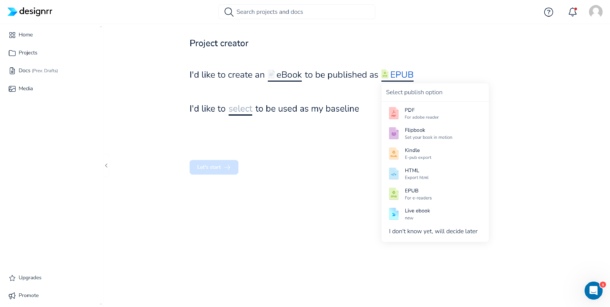
- Select “Use Wordgenie” if you want to use the AI or if you have a long blog article or video you want to convert into an ebook.
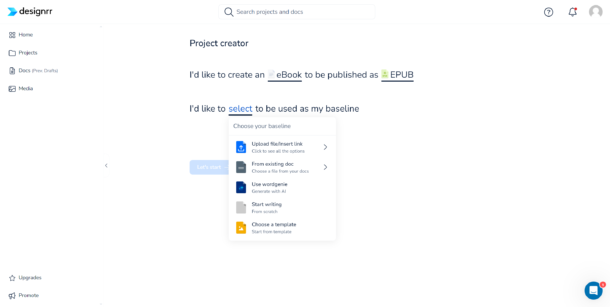
- Select the topic theme that closely aligns with yours.
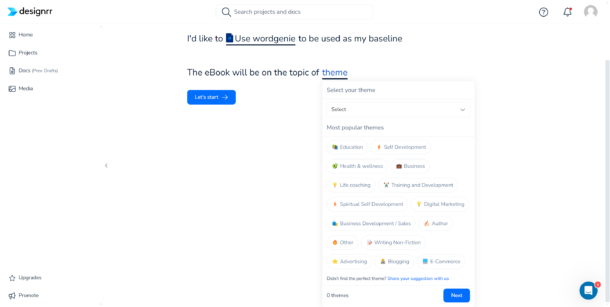
- Enter the topic and language.
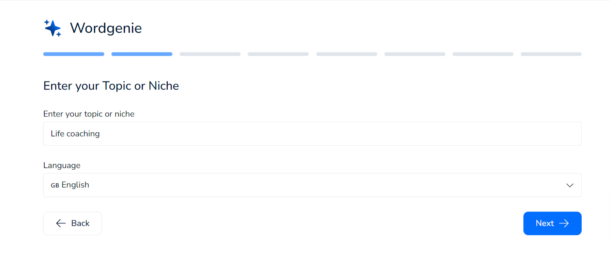
- Define your ebook’s sub-niche.
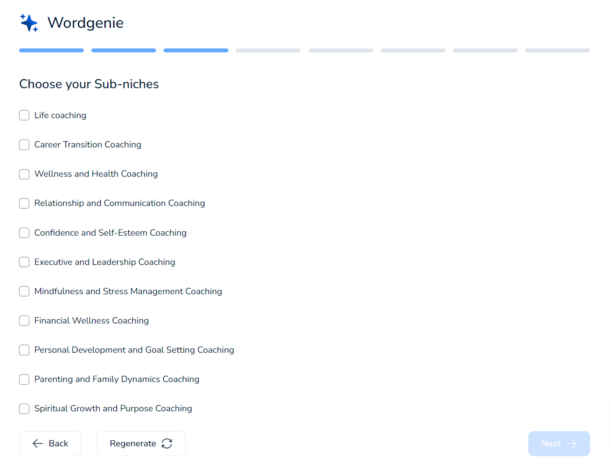
- Enter your target audience.
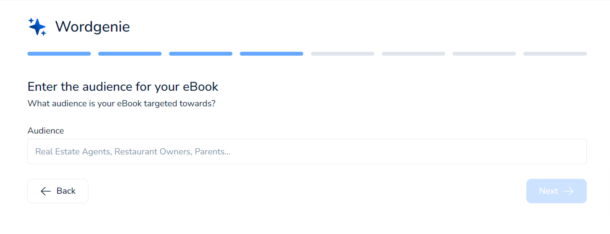
- Choose or regenerate to get title suggestions.

- Select the tone of voice for your ebook.
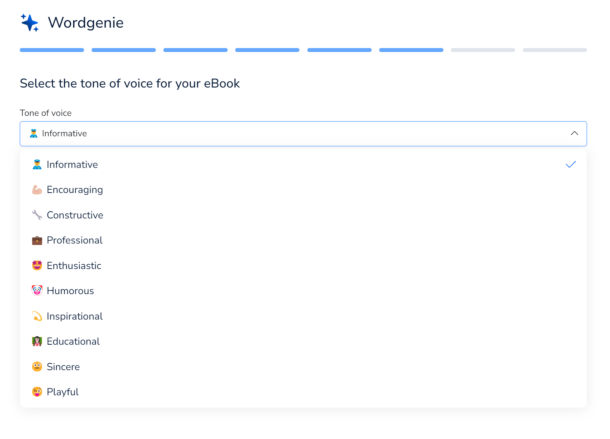
- Let Designrr generate your ebook outline; make changes if needed.

Read our guide on how to use AI to outline your ebook.
- Let Designrr AI write the entire ebook in one go.

- Select the ebook design that will make your ebook pop.
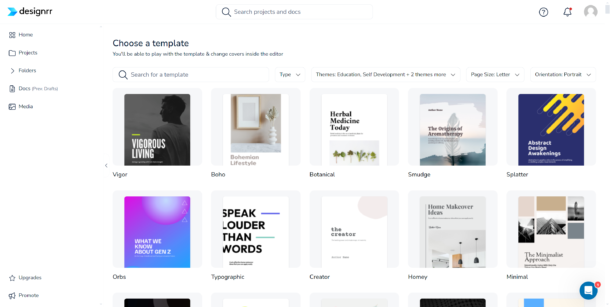
- It will automatically select the font and content format that best resembles that design. You can change and add your own touch directly to the ebook.
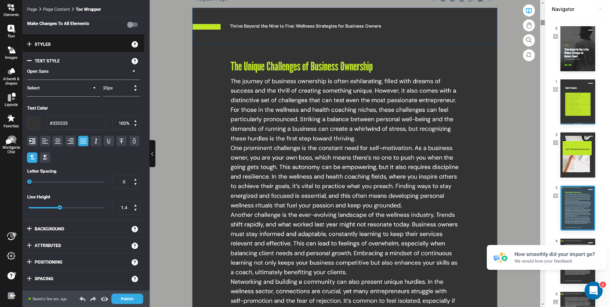
Make sure to read our article on how to edit AI content for your ebook.
- You can select multiple ways to provide your ebook to your readers.
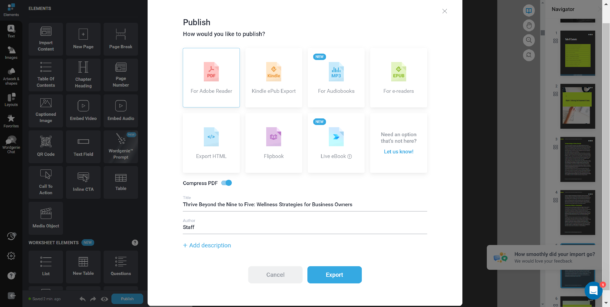
That’s it! It’s that simple.
Check the video and sign up for Designrr’s special offer today!
8. Publish and Spread the Word About Your Ebook
Great job! You’ve written, edited, designed, and formatted your ebook. Now it’s time to launch your ebook and share it with the world. The exact steps for uploading and publishing will depend on where you choose to sell your book, but ChatGPT can help you get ready to launch and figure out how to tell people about your book.
Use ChatGPT to:
- Write a great book description
- Create posts for social media
- Write emails to tell people about your book
- Think of ways to promote your book
- Find people who might want to review your book
- Plan out your launch timeline
For creating social media content, use this prompt:
“Write 5 engaging Twitter posts to promote my new ebook [your ebook title] to [your target audience].”
Important things to think about when publishing and promoting your ebook:
- Choose Where to Sell: Decide if you want to sell only on one platform (like Amazon) or on many different ones.
- Set the Right Price: Think about how long your book is, how much value it gives, and what similar books cost.
- Tell People You Know: Let your contacts know about your book launch.
- Make a Website for Your Book: Create a page that shows why people should buy your book.
- Write Related Content: Create blog posts or articles that connect to your book to get people interested.
- Try Paid Ads: Start small with ads on places like Amazon or Facebook.
- Ask for Reviews: Reach out to book bloggers, influencers, or your own readers for honest reviews.
- Have a Launch Event Online: Get people excited with a webinar or live Q&A session.
- Offer a Special Deal: Think about offering a discount when you first launch to encourage early sales.
- Keep Track of How You’re Doing: Use the data you get to make your strategies better over time.
Promoting your ebook is an ongoing process. Don’t feel bad if you don’t see big results right away. Keep working on your approach, talking to your audience, and creating valuable content to support your ebook.
Overcoming Common Challenges
Even with ChatGPT’s help, you might hit some bumps along the way. Here are some common challenges and how to tackle them:
Writer’s Block:
Ask ChatGPT:
“I’m stuck on [topic]. Can you suggest 5 different angles to approach this?”
Take a break and come back with fresh eyes.
Information Overload:
Use ChatGPT to help organize your thoughts:
“Here are my main ideas [list ideas]. Can you suggest a logical order for presenting these?”
Keeping Reader’s Interest:
Ask ChatGPT:
“How can I make this section on [topic] more engaging for my readers?”
Maintaining Consistency:
Create a style guide and refer to it often.
Use ChatGPT to check for consistency:
“Does this paragraph match the tone and style of my previous chapter?”
Technical Difficulties:
Don’t be afraid to ask for help in online forums or hire a professional for tricky formatting issues.
Remember, every author faces challenges. The key is to keep moving forward, one step at a time.
Ethical Considerations and Best Practices
While ChatGPT is a powerful tool, it’s important to use it responsibly:
- Fact-Check: Always verify any facts or statistics ChatGPT provides.
- Add Your Voice: Use ChatGPT’s suggestions as a starting point, but infuse your unique perspective and experiences.
- Cite Sources: If ChatGPT helps you find information, make sure to properly cite the original sources.
- Be Transparent: If you’re comfortable doing so, consider mentioning in your book that you used AI as a writing aid.
- Respect Copyright: Ensure that any content you use, whether generated by ChatGPT or not, doesn’t infringe on others’ copyrights.
Wrapping Up
Writing an ebook is more than just putting words on a page – it’s a chance to learn, be creative, and grow. With ChatGPT as your writing buddy, you have a powerful tool to help you tackle challenges and make the most of opportunities along the way.
Your ebook shows what you know, what you’re passionate about, and how you want to help your readers. Enjoy the process, trust that you have something valuable to say, and don’t be afraid to share your ideas with the world.
No matter if your ebook becomes a bestseller, opens new doors for you, or just helps a few dedicated readers, creating and sharing it is a big accomplishment.
So, take a deep breath, open a new document, and start writing. There are readers out there waiting for what only you can tell them. With determination, creativity, and some help from ChatGPT, you have everything you need to create an ebook that informs, inspires, and makes a real difference.
Good luck with your writing, and here’s to your ebook success!
